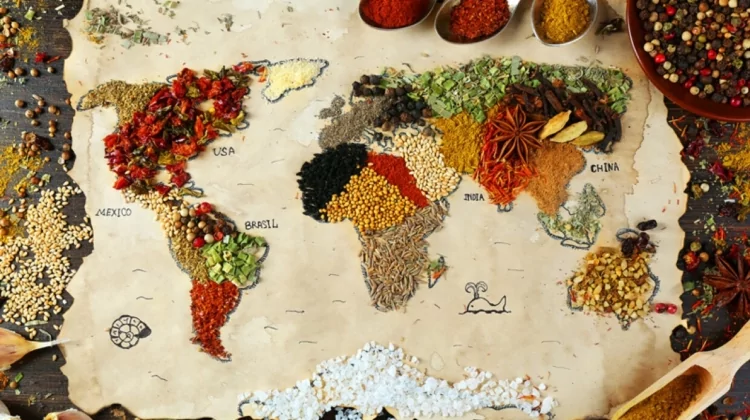
[Want even more content from FPM? Sign up for FPM+ to unlock exclusive series, virtual town-halls with our authors, and more—now for just $3.99/month. Click here to sign up.]
Thai. Chinese. Korean BBQ. Mexican tacos. Japanese sushi. Indian curry. Traveling the streets of any major American city is an adventure in culinary globalism. There are more Chinese restaurants than McDonald’s and 1 in 10 restaurants serve Mexican food.
Culinary globalization has robbed American food of its character and the proliferation of fast food and the disintegration of the American family has made cooking into a luxury. And there’s little American left in our food except for its raw ingredients, and even that often harvested by migrant labor in an agricultural system aimed at global exports.
Americans have never been food nationalists and maybe that’s part of the problem. Other countries and cultures zealously advocate for their own cuisines. Thailand’s ‘culinary diplomacy’ planted Thai restaurants around the world, training chefs, subsidizing new eateries as part of a plan to spread its culture abroad and create demand for its food exports. The French resent and litigate when anyone drinks champagne that doesn’t come from the Champagne region. Americans however tend not to care. Worse still we have come to despise our own culture and cuisine.
This may seem trivial, but the British started out despising English cuisine and ended up importing not only the cuisines of the world, but the people who run the takeaways, like the kebab joints where a generation of English girls in former manufacturing towns were sexually assaulted and prostituted. Despising elements of our own culture can start out as a running joke, but end in national humiliation and destruction.
Americans have trouble appreciating our own cuisine because it has all too often come to mean the hybridized immigrant pre-fast foods that vendors evolved on the streets of American cities, like hamburgers, frankfurters, pizza and ice cream cones, and then spread around the world. This American food globalism was denounced by the Europeans, but proved irresistible and became the fast food of the entire planet.
Fast food has no national character except an obsession with convenience and speed over content. And so by 1888 the Boston Globe could observe that, “eating is a matter of business with Americans. They do it as they perform all other kinds of work – on the rush.” The new national character was speed at all costs and it became the international perception of America. But the industrialization of food robbed it of character. Cuisines crumbled under the pressures of mass production. It was easier to add sweeteners, sauces and fats to fake flavor than to take the time to produce dishes with actual taste.
The MAHA or Make America Healthy Again movement questions the healthfulness of fast food, but the larger question may be not whether fast food is healthy for our bodies, but whether it’s healthy for our souls. Fast food and later microwavable TV dinners marked the disintegration of the kitchen and dining room as the center of family life.
One of the conveniences of fast food was that it did not require family or a home.
Before fast food was the dream of McDonald’s and Burger King, it was the dream of the Soviet Union which in its early days planned homes without kitchens to make everyone eat in mass cafeterias. This particular experiment in culinary collectivism sought to eliminate the private space of the family kitchen and place it under state control.
And long before that, slaves in ancient Egypt were fed a diet of thick almost solid beer and crude bread to keep them going. Meals were seen as the province of the wealthy while ancient fast food was for the poor. Adopting fast food impoverished us and put our personal lives and mealtimes at the service of corporations.
American cuisine before the arrival of urban street food took advantage of the rich variety of agriculture and wildlife to be found in colonial America. The early settlers struggled with growing imported grains, but soon found access to a rich variety of foods, native grains, along with animals and birds that they could hunt without worrying about being accused of poaching by some nobleman, and soon the American farmer was enjoying a life that his European peasant counterpart could not even begin to imagine.
American regionalism produced local cuisines from New England to New Orleans that reflected these developing cultures. From pineapple to turtle soup, more exotic foods took on larger meanings and became metaphors for everything from hospitality to artifice. But the pineapple, as a symbol of giving the best to one’s guest, is nearly forgotten except when seen decorating the carvings of older homes and dishes.
Urbanization, industrialization and immigration displaced traditional American foods. The migration to cities was the first disruptive blow to the American family. Large populations of young single men working long hours needed easy eating. And a population of immigrants provided cheap labor by breaking down their native cuisines into something to serve to that itinerant working class mostly male population.
This was followed by the era of orientalism when American culture looked to Asia and the Middle East for models. American elites broadened their former interests in Europe by traveling to exotic third world locations, importing their philosophies, cultures, religions and also cuisines. American elites had looked to Europe as being wiser and deeper than their own culture, now similarly looked down on their own country as backwards and provincial, and looked for inspiration to some of the most backward places in the world.
American cuisine was captured at the top and the bottom, by the elites (and the middle class which copied the habits of their perceived betters), and by the working class. And vital national and regional cuisines were replaced by foreign and fast foods.
Many of these foods are not just unhealthy for individuals, they’re socially and culturally unhealthy for the country. Making American food great again can’t just be about following the constantly changing trends of what is considered “healthy”, but about reviving a national cuisine within the larger context of a national culture.
American cuisines were rooted in the richness of the land, but agribusiness, often owned by foreign money, has appropriated the land to grow export crops. Americans are currently paying record prices for eggs to protect that export business. Mass agribusiness eroded local cuisines and replaced the need for variety with foreign foods.
As Thailand shows us, exporting cuisines is also exporting agriculture, but America now exports raw agricultural materials and imports foreign cuisines. Importing cuisines also imports cultures and immigrants. The globalization of American food is also the globalization of America. The state of our food cannot be separated from the state of our state.
The connection between character and cooking even led Thomas Jefferson to say of the English that, “I suspect it is in their kitchens & not in their churches that their reformation must be worked.” These days, American food is almost in as much of a need of reform as its English counterparts. Making American food great again requires beginning with not just what we eat, but why we eat it and what it says about us.















